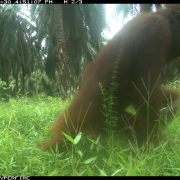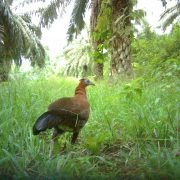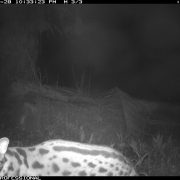In Malaysian Borneo, conservationists are endeavouring to find solutions to wildlife challenges that benefit both humans and wildlife alike.
HUTAN is one of Chester Zoo’s longest standing conservation partners, and their flagship project, the Kinabatangan Orangutan Conservation Project (KOCP), has been running since 1998. Working in Malaysian Borneo, the KOCP vision is for orangutan and other threatened species to thrive in mosaic landscapes where forest and agriculture must co-exist.
Across the globe, approaches to conservation are shifting. Human and wildlife populations living side by side is an inevitability of our modern world, and one that HUTAN-KOCP has embraced. The organisation works in the forests of Kinabatangan, located at the northern tip of the Island of Borneo. These forests are one of the world’s richest biodiversity hotspots, home to clouded leopard, sun bear, Bornean elephants and a bounty of life across bird, amphibian, reptile and invertebrate taxa. Most notably, those visiting the forests can hope to see the flash of orange fur amongst the trees belonging to one of the resident populations of Bornean orangutans.
Despite the existence of this wildlife treasure trove, human activity has taken its toll over the years. Deforestation and agricultural development have heavily degraded and fragmented the forest, leaving a mosaic landscape of forest patches surrounded largely by oil palm plantations, the region’s greatest economic asset.
The issue of palm oil is an incredibly complex one. We are confident that, when sustainably managed, palm oil has a place in sustaining an economic future for people while still allowing wildlife space to survive and thrive. You can find our full position on sustainable palm oil here. HUTAN have been a major partner in, and advocate of, Chester Zoo’s well-established palm oil campaign.
The challenge for HUTAN-KOCP has been to strike the balance between human needs and those of orang-utan and other wildlife.
During 2019, the HUTAN Orangutan Research Unit has built on over 20 years of study, making further discoveries that have shed a bright light on a more sustainable future. By closely monitoring and following orangutan population in the Kinabatangan floodplain, the team observed that orangutans in many areas used oil palm plantations for dispersal between forest fragments, nesting, and as a food source.
These discoveries should not come as a surprise. Increasingly, we are starting to understand how wildlife is adapting to persist in agricultural landscapes. Earlier this year, Chester Zoo participated in key research uncovering the potential importance of a sustainably managed agricultural landscape for green peafowl in Myanmar.
In the Kinabatangan, the story is complex. The answer for a long-term future lies in securing connectivity in non-protected areas of forest-agriculture mosaic, and implementing land management practices compatible with orangutan survival.
HUTAN is working with plantation owners, local communities and the Sabah Wildlife Department in the Kinabatangan forests to generate forest corridors between patches, maximising living space and connectivity not only for the threatened primates that live there, but for each of the key species that share their home.
Last year, over 30,000 seedlings from 29 different species of native tree were planted on land donated by the Genting Palm Oil Plantation to restore a critical corridor connecting the Lower Kinabatangan Wildlife Sanctuary and Keruak Jungle Forest Reserve. This work has been supported through the Co-op’s Future of Food Sourcing Project, and includes an important research element conducted by HUTAN’s Amanda Shia. Amanda’s research, conducted as part of a master’s degree with Manchester Metropolitan University, will ultimately provide recommendations for best practise to restore, connect and promote wildlife in oil palm-forest mosaic landscapes and provide evidence for effective methods to monitor wildlife recovery. Amanda’s results already show that 80% of the seedlings have survived one year on, with some trees already reaching over 3 meters in height. Camera trap records and other monitoring methods are currently being analysed, but preliminary results already indicate that the reforested plots are successfully providing a new corridor that wildlife are utilising. Chester Zoo are also supporting similar HUTAN activities to plant 30,000 native trees that will restore a 25-hectare riverine forest corridor in the Melangking Oil Palm Plantation.
To learn more about this effort, check out the below video from HUTAN’s Scientific Director, Marc Ancrenaz:
Of course, habitat loss and fragmentation are not the only issues facing Kinabatangan’s orangutans, and land management and restoration is one part of a much bigger, holistic suite of conservation activities. HUTAN lead a wildlife monitoring and protection unit, aimed to control the illegal activities threatening orangutans, as well as other species affected heavily by the wildlife trade, such as various species of hornbill.
HUTAN also continues to deliver many other fantastic outputs, from capacity building to large-scale reforestation projects. The HUTAN Environmental Awareness Programme (HEAP) for example provide conservation messaging across a range of regional stakeholders, and Chester Zoo’s education experts have played a critical role in helping to drive the direction of this scheme through training and workshops to help develop an education master plan. We’re excited to continue our involvement in the years ahead as the work expands its reach.
Amanda’s research will also excitingly have potentially wider implications. In 2020 and 2021, we will ensure continued management to further restore forest corridors, and continued monitoring will allow evidence-based recommendations for management of wildlife in forest-agricultural mosaic landscapes relevant for HUTAN’s continued corridor creation but also initiatives across Borneo and further afield.
We’ll continue to work side-by-side with HUTAN-KOCP to guarantee a safe future for the incredible biodiversity under their protection, and to inspire those sharing Malaysian Borneo to join them in achieving this vision.
Check out our work with HUTAN Education Awareness Programme (HEAP), where we help to develop a strategic plan for their learning programmes alongside HEAP coordinator here



